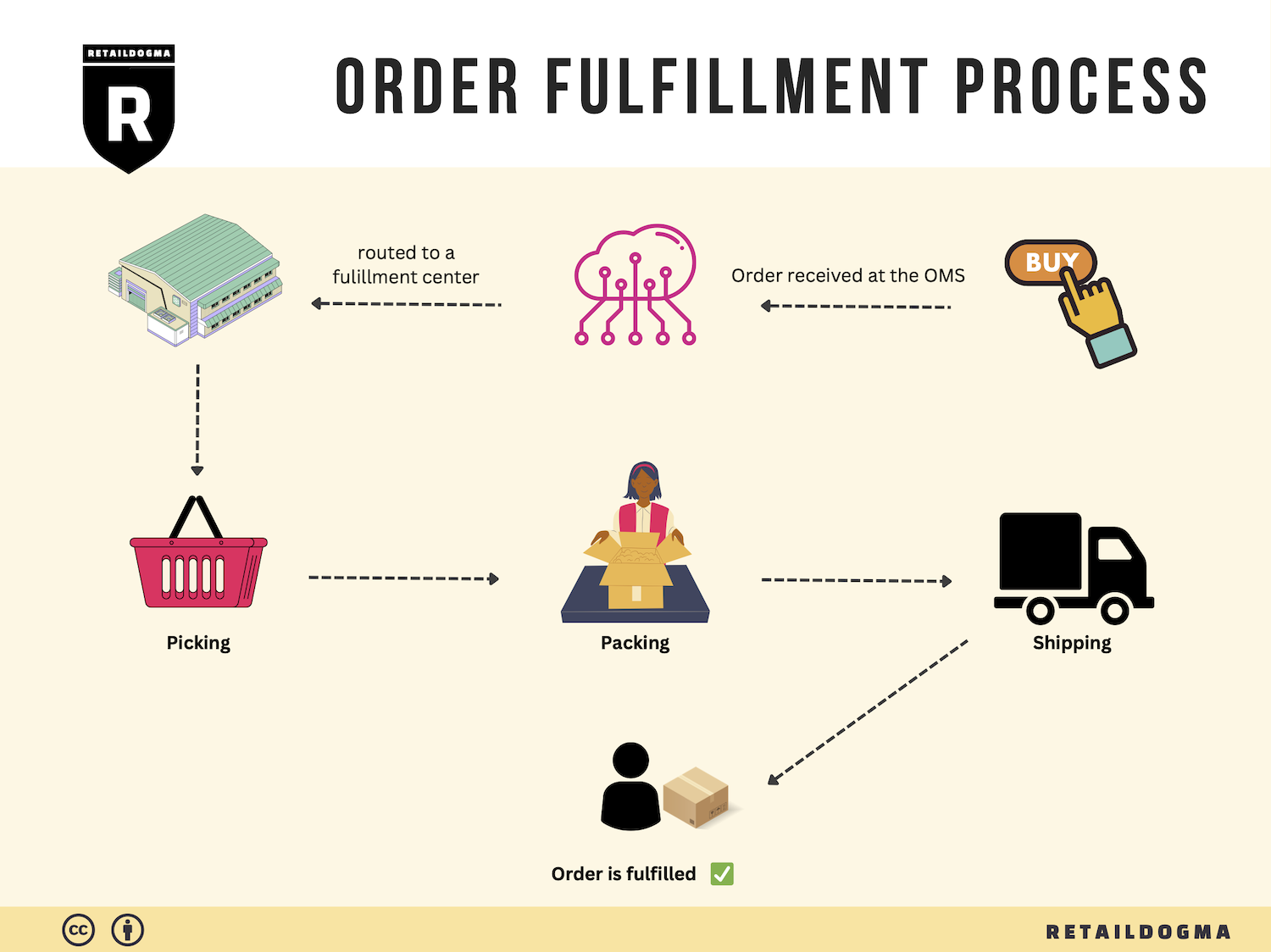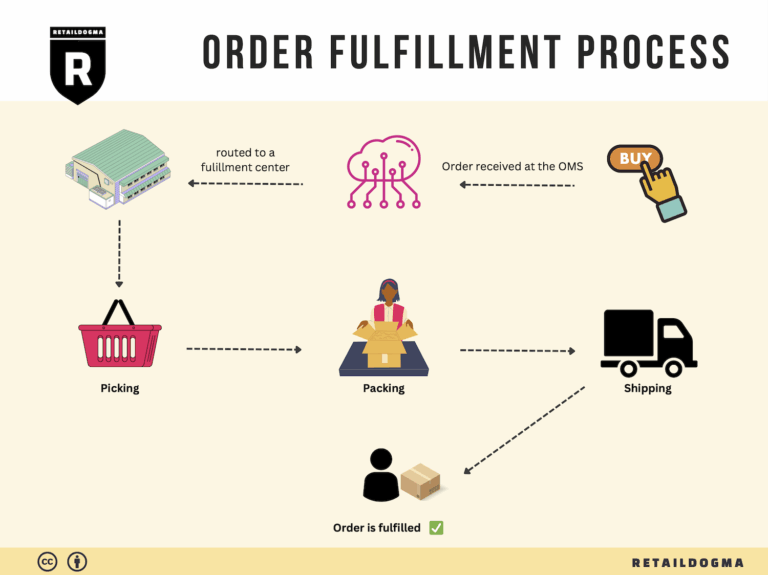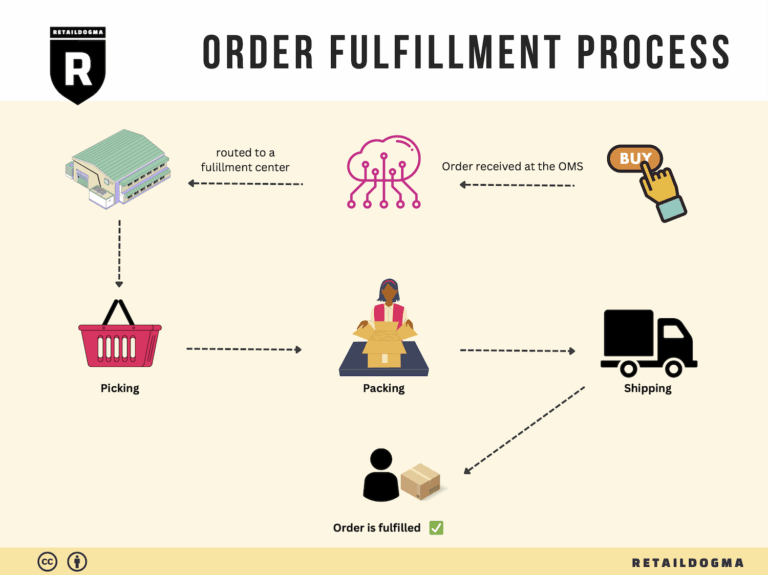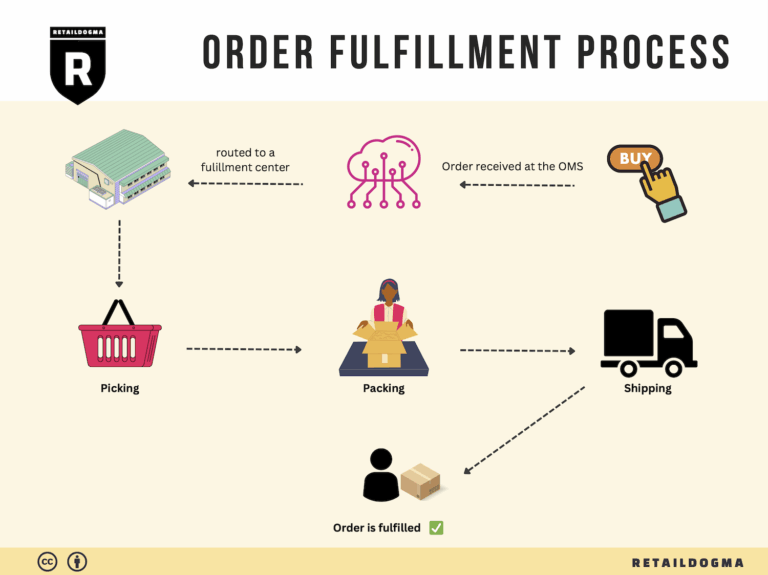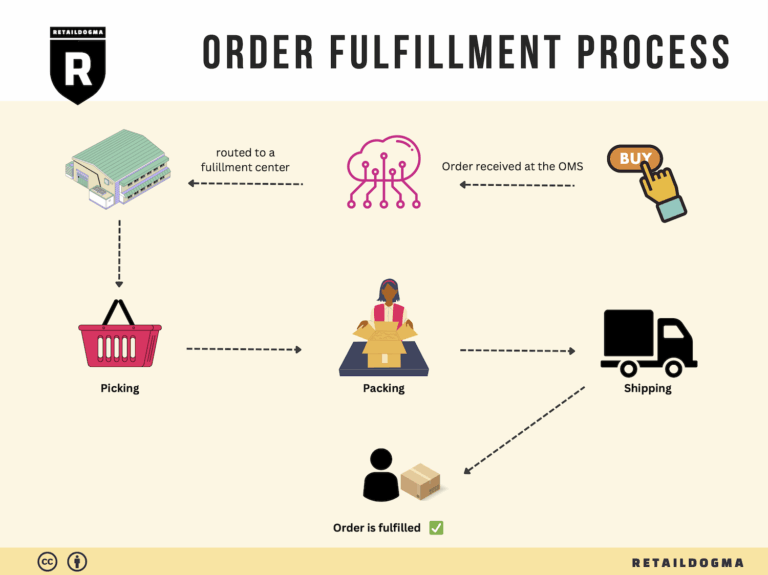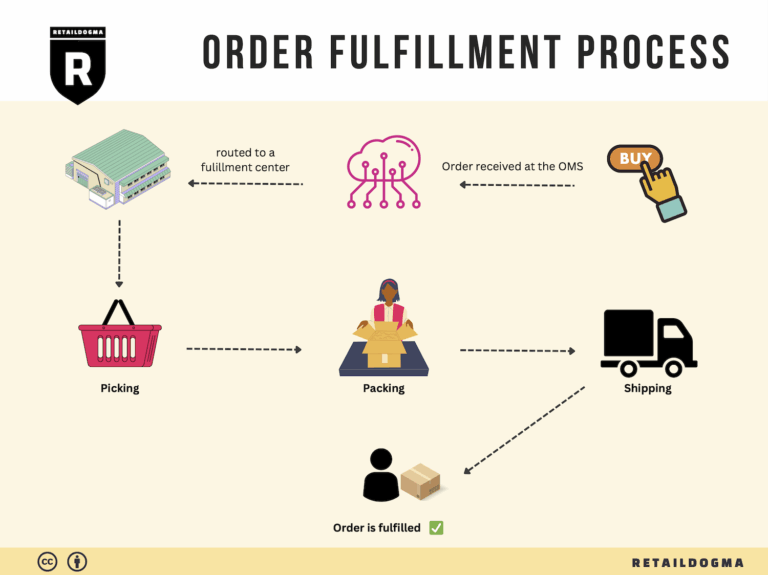Ecommerce Fulfillment Services: The Ultimate Guide (2025)
What is E-commerce Fulfillment? An Introduction for Growing Businesses
Introduction to E-commerce Fulfillment
As an e-commerce business owner, you may find yourself grappling with the overwhelming task of packing and shipping orders. It’s a common challenge that often distracts from the core activities of marketing and growing your business. Fulfillment, in its simplest form, is the process of getting a product into the hands of your customers. This encompasses everything from warehousing inventory to picking, packing, and shipping orders, as well as handling returns. As your business scales, mastering fulfillment becomes crucial to maintaining customer satisfaction and driving repeat sales.
This guide aims to demystify the complexities of e-commerce fulfillment and provide you with practical insights to streamline your logistics operations. We will explore various fulfillment models, such as Third-Party Logistics (3PL) and Fulfillment by Amazon (FBA), helping you understand the benefits and limitations of each. You’ll learn about the core services involved in fulfillment, including inventory management, order processing, and shipping strategies.
Choosing the right fulfillment partner can make a significant difference in your business’s efficiency and customer experience. We’ll outline the key factors to consider when selecting a partner, from technology integration to order accuracy and customer service. Additionally, we will discuss pricing structures, enabling you to evaluate costs effectively and make informed decisions that align with your budget and growth goals.
Ultimately, this guide seeks to empower you—whether you’re a small startup or a growing enterprise—to navigate the logistics landscape confidently. By understanding fulfillment’s role in your business and making strategic decisions about your logistics operations, you can enhance your customer experience, optimize your processes, and focus on what truly matters: scaling your sales and building a beloved brand.
What You’ll Learn In This Guide
- What is E-commerce Fulfillment? An Introduction for Growing Businesses
- The Order Fulfillment Process: From ‘Buy’ Button to Customer’s Door
- Comparing Fulfillment Models: In-House vs. 3PL vs. Dropshipping
- A Deep Dive into Amazon FBA: Pros, Cons, and Who It’s For
- Core Services Offered by Fulfillment Centers
- How to Choose a Fulfillment Partner: A 6-Point Checklist
- Understanding Fulfillment Pricing: A Breakdown of Common Fees
- Frequently Asked Questions (FAQs) about Fulfillment
- Conclusion: Is Outsourcing Fulfillment the Right Move for Your Business?
- Important Disclaimer
The Order Fulfillment Process: From ‘Buy’ Button to Customer’s Door
1. Receiving Inventory
The first step in the order fulfillment process is receiving inventory. This involves the physical delivery of products from suppliers to your warehouse or fulfillment center. When the shipment arrives, it’s crucial to check the contents against the purchase order to ensure accuracy. Each item should be verified for quality and quantity, which helps in maintaining accurate stock levels.
Importance: Proper inventory receiving is essential because it sets the foundation for all subsequent steps in the fulfillment process. Discrepancies at this stage can lead to stockouts, overstock situations, and ultimately dissatisfied customers. Effective inventory management helps in maintaining a reliable supply chain.
Key Term: SKU (Stock Keeping Unit) – Each product is assigned a unique SKU to track inventory effectively. This code is vital for inventory management and assists in the quick identification of products during the fulfillment process.
2. Warehouse Storage
Once inventory is received and verified, the next step is warehouse storage. Products are organized and stored in designated locations within the warehouse. Efficient storage practices involve categorizing items based on size, type, and demand frequency. High-demand items should be placed in easily accessible areas to speed up the picking process later on.
Importance: Effective warehouse storage maximizes space utilization and minimizes the time spent searching for products. A well-organized warehouse can significantly enhance operational efficiency, reduce labor costs, and improve order accuracy.
Key Term: ABC Analysis – This inventory categorization technique divides items into three categories (A, B, and C) based on their importance and sales frequency. ‘A’ items are high-value products with low sales frequency, while ‘C’ items are low-value products with high sales frequency.
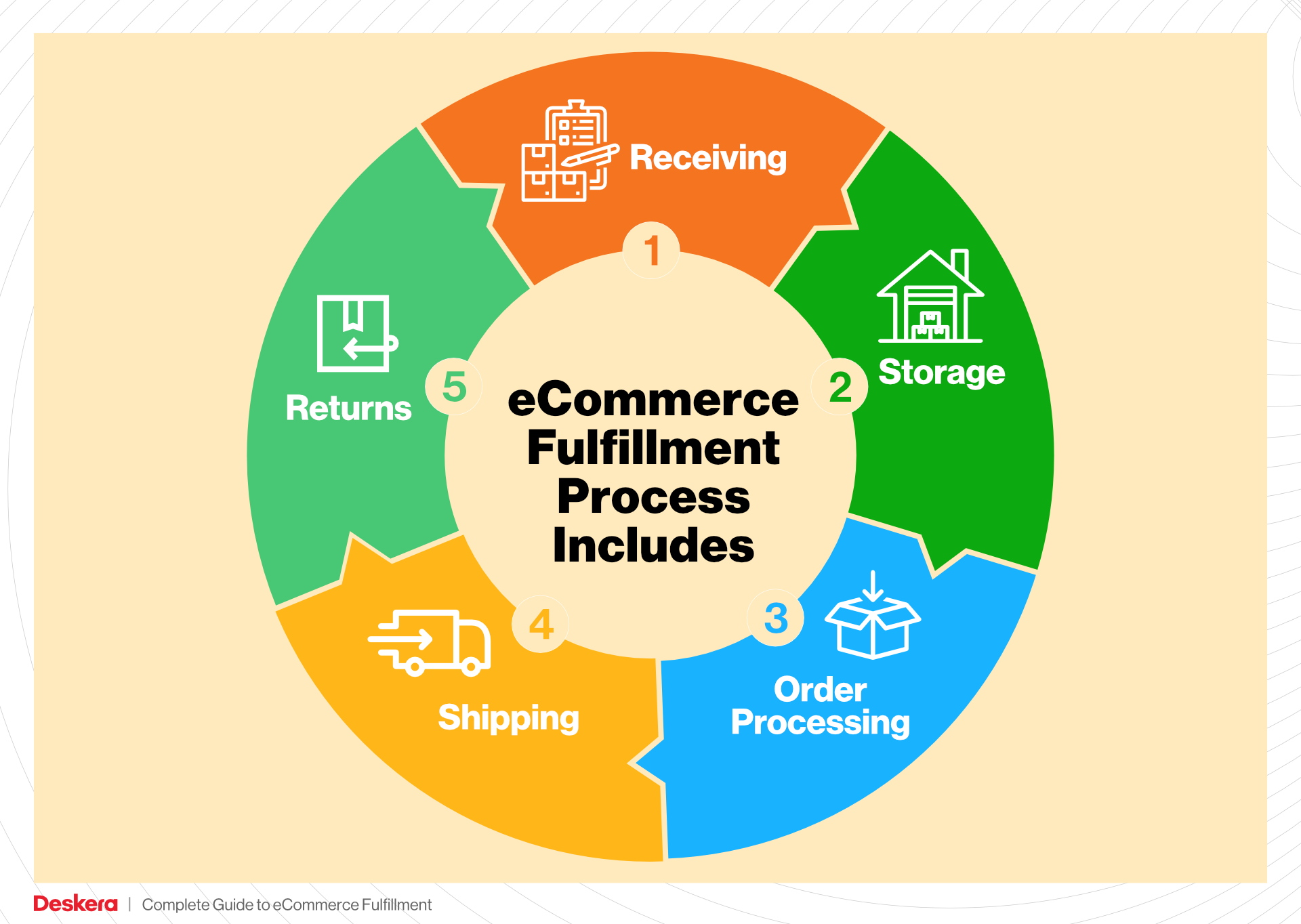
3. Order Picking
Order picking is the process of selecting the right items from the warehouse to fulfill a customer order. Once an order is placed, a pick list is generated, which specifies the items and their locations in the warehouse. Warehouse staff then retrieve these items, ensuring they match the order details.
Importance: This step is critical as it directly impacts order accuracy and fulfillment speed. Errors in picking can lead to incorrect shipments, resulting in returns and customer dissatisfaction. Streamlining the picking process can enhance operational efficiency and improve customer satisfaction.
Key Term: Pick List – A document or digital interface that details the items to be picked for an order, including their locations in the warehouse. Efficient pick lists help reduce the time spent locating products.
4. Order Packing
After the items have been picked, they move to the packing stage. This involves securely packaging the products for shipment, which includes selecting the right packaging materials, adding protective fillers, and labeling the package appropriately. The packing process should also include a final quality check to ensure the right items are included and are in good condition.
Importance: Proper packing is crucial for protecting products during transit and ensuring they arrive at the customer’s door in excellent condition. Additionally, professional packaging enhances the unboxing experience, which can positively influence customer perception of your brand.
Key Term: Packing Slip – A document included in the package that outlines the items inside, serving as a receipt for the customer. It also helps in verifying that the correct items have been packed.
5. Shipping & Delivery
The final step in the order fulfillment process is shipping and delivery. Once the package is packed, it is handed over to a shipping carrier. Businesses need to choose reliable carriers and establish a shipping strategy that optimizes cost and delivery times. Offering multiple shipping options can enhance customer satisfaction by providing flexibility.
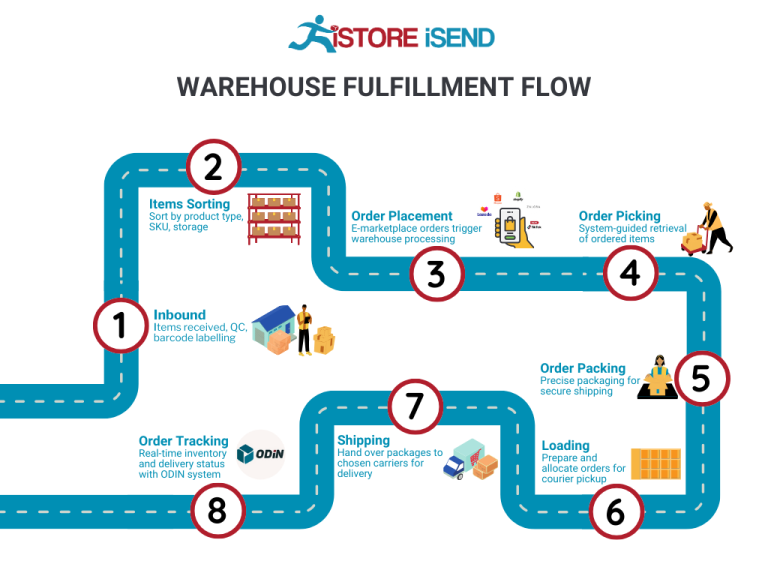
Importance: Timely and reliable delivery is a key factor in customer satisfaction. The shipping experience can significantly affect repeat purchases and brand loyalty. Therefore, monitoring carrier performance and managing last-mile delivery effectively is critical for maintaining a positive customer experience.
Key Term: Last-Mile Delivery – This term refers to the final leg of the delivery journey, where the package is transported from a distribution center to the customer’s doorstep. Efficient last-mile delivery is essential for meeting customer expectations regarding delivery times and service quality.
By understanding and optimizing each step of the order fulfillment process, e-commerce businesses can enhance their operational efficiency, improve customer satisfaction, and ultimately drive growth. Each stage plays a crucial role in creating a seamless experience from the moment a customer clicks the “Buy” button to the time their order arrives at their door.
Comparing Fulfillment Models: In-House vs. 3PL vs. Dropshipping
Comparing Fulfillment Models
| Model | Who Handles Inventory | Best For (Business Stage) | Key Advantage | Key Disadvantage |
|---|---|---|---|---|
| In-House Fulfillment | Business owns inventory | Established brands with stable sales | Full control over processes and inventory | High overhead costs and labor-intensive |
| Third-Party Logistics (3PL) | 3PL provider manages inventory | Scaling businesses needing flexibility | Scalability and reduced operational burden | Less control over fulfillment processes |
| Dropshipping | Supplier/manufacturer handles inventory | Startups and businesses with limited capital | Low upfront investment and risk | Lower profit margins and reliance on suppliers |
In-House Fulfillment
In-house fulfillment involves managing the entire order processing and shipping process within the business itself. This model is typically suited for established brands that have stable sales and a predictable volume of orders. By handling inventory internally, businesses can maintain full control over their fulfillment processes, ensuring quality and consistency in how products are packed and shipped. This can enhance the customer experience, as companies can implement their own standards and practices. However, the downside to in-house fulfillment is the significant overhead costs associated with warehousing, staffing, and logistics management. As order volumes increase, businesses may find themselves stretched thin, leading to inefficiencies and potential service issues. Additionally, the labor-intensive nature of this model may not be sustainable as the business scales, potentially hindering growth.
Third-Party Logistics (3PL)
Third-party logistics (3PL) providers offer a flexible fulfillment solution by managing inventory and shipping on behalf of e-commerce businesses. This model is particularly advantageous for companies looking to scale quickly, as it allows them to leverage the expertise and infrastructure of established logistics providers. 3PLs typically have robust technology integrations with e-commerce platforms, enabling seamless order processing and real-time inventory management. This can significantly reduce operational burdens for businesses, freeing them to focus on core competencies like marketing and product development. However, the trade-off is a loss of direct control over fulfillment processes, which can lead to inconsistencies if the 3PL does not align closely with the brand’s standards. Additionally, businesses must carefully vet potential 3PL partners to ensure they have a proven track record of reliability and customer service.
Dropshipping
Dropshipping is a fulfillment model where the retailer does not keep goods in stock but instead transfers customer orders directly to the supplier, who then ships the products to the customer. This model is particularly attractive for startups and businesses with limited capital, as it requires little to no upfront investment in inventory. Entrepreneurs can test new products without the financial risk of holding stock, making it easier to pivot based on market demand. However, dropshipping comes with its own set of challenges. The reliance on suppliers means that businesses have less control over product quality, shipping times, and inventory levels, which can lead to customer dissatisfaction. Furthermore, profit margins can be lower in dropshipping compared to other fulfillment models, as retailers must account for supplier costs while competing in a crowded marketplace. As a result, while dropshipping offers flexibility, it may not be the best long-term solution for businesses aiming to build a strong brand and loyal customer base.
By understanding these fulfillment models, e-commerce business owners can make informed decisions about the best approach to meet their operational needs and growth objectives. Each model presents unique advantages and challenges, and the choice largely depends on the specific context and goals of the business.
A Deep Dive into Amazon FBA: Pros, Cons, and Who It’s For
Understanding Fulfillment by Amazon (FBA)
Fulfillment by Amazon (FBA) is a service offered by Amazon that allows e-commerce sellers to store their products in Amazon’s fulfillment centers. When a customer places an order for a product, Amazon takes care of storage, packaging, shipping, and customer service on behalf of the seller. This service is particularly attractive for businesses looking to scale their operations while leveraging Amazon’s extensive logistics network.
How FBA Works
-
Inventory Storage: Sellers send their inventory to Amazon’s fulfillment centers, where it is stored until sold. Amazon provides detailed guidelines on how to prepare and package products for shipment to ensure they meet their standards.
-
Order Fulfillment: Once a customer places an order, Amazon picks, packs, and ships the product directly to the customer. This process is streamlined, allowing for quick and efficient delivery.
-
Customer Service: Amazon handles all customer service inquiries related to the FBA products, including returns and refunds, providing a seamless experience for both sellers and customers.
-
Prime Eligibility: Products fulfilled through FBA are automatically eligible for Amazon Prime, which can significantly increase visibility and sales potential.
-
Multi-Channel Fulfillment: Sellers can also use FBA to fulfill orders from other sales channels, such as their own websites or other marketplaces, allowing for a centralized inventory and streamlined operations.
Pros of Amazon FBA
-
Prime Eligibility: One of the most significant advantages of using FBA is that products become eligible for Amazon Prime. This increases the likelihood of sales as Prime members tend to prefer Prime-eligible products due to faster shipping options.

-
Customer Trust: Amazon’s reputation for reliability and customer service extends to FBA products. Customers are more likely to purchase from sellers using FBA because they trust Amazon’s fulfillment processes, including returns and support.
-
Scalability: FBA allows sellers to scale their businesses without the need to invest heavily in warehousing and logistics. This is particularly beneficial for small to medium-sized businesses looking to grow quickly.
-
Time Savings: By outsourcing fulfillment to Amazon, sellers can focus on other aspects of their business, such as product development and marketing, rather than logistics.
-
Advanced Logistics: Amazon’s extensive logistics network means that orders can be fulfilled quickly, often with same-day or next-day delivery options, enhancing customer satisfaction.
-
Multi-Channel Fulfillment: FBA enables sellers to fulfill orders from various sales channels, including their own websites. This centralization of inventory can simplify operations and inventory management.
Cons of Amazon FBA
-
High Fees: FBA comes with various fees, including storage fees for keeping products in Amazon’s warehouses and fulfillment fees for each order processed. These costs can add up quickly, eating into profit margins.
-
Strict Inventory Rules: Amazon has stringent guidelines regarding inventory storage and management. Sellers must adhere to these rules, or risk having their inventory removed or incurring additional fees.
-
Commingling Risks: Amazon may commingle inventory from multiple sellers, meaning that your product could be mixed with others in the warehouse. This can lead to issues if a customer receives a damaged or defective item that wasn’t yours, potentially harming your seller reputation.
-
Limited Control Over Fulfillment: While FBA provides a hands-off approach to fulfillment, it also means sellers have less control over the shipping process, packaging, and customer service interactions. Any issues that arise can impact your brand’s reputation.
-
Inventory Management Challenges: Sellers need to carefully manage their inventory levels to avoid long-term storage fees or stockouts. This requires a strong understanding of sales trends and demand forecasting.
-
Returns Management: While Amazon handles customer returns, the process can be less favorable for sellers. Returned items might not be in resellable condition, leading to potential losses.
Who is FBA Best For?
Fulfillment by Amazon is particularly well-suited for:
-
Small to Medium-Sized Businesses: Companies looking to scale without investing heavily in logistics infrastructure will find FBA advantageous.
-
E-commerce Entrepreneurs: Those who want to focus on product development and marketing rather than logistics will benefit from Amazon’s robust fulfillment capabilities.
-
Brands Seeking Prime Exposure: Sellers who want to tap into the Prime customer base and leverage Amazon’s reputation will find FBA essential for increasing sales.
-
Multi-Channel Sellers: Businesses that sell on multiple platforms can utilize FBA for streamlined order fulfillment, improving efficiency and reducing complexity.
-
Seasonal Sellers: For businesses that experience spikes in sales during certain times of the year, FBA offers a flexible solution for handling increased order volumes without long-term commitments to warehousing.
In conclusion, Amazon FBA can be a powerful tool for e-commerce businesses looking to simplify their logistics and enhance their customer experience. However, it’s crucial for sellers to carefully weigh the pros and cons to determine if FBA aligns with their business goals and operational capabilities.
Core Services Offered by Fulfillment Centers
Inventory Management & Warehousing
Inventory management and warehousing are foundational services offered by fulfillment centers that enable e-commerce businesses to efficiently store and track their products. Fulfillment centers typically provide dedicated warehouse space where businesses can store their stock, ensuring that products are readily available for order fulfillment.
One of the primary benefits of effective inventory management is the ability to maintain optimal stock levels. This minimizes the risk of stockouts, which can lead to lost sales and dissatisfied customers, as well as overstock situations, which can tie up valuable capital. Fulfillment centers use advanced inventory management systems that integrate with e-commerce platforms to provide real-time visibility into stock levels. This integration allows businesses to make data-driven decisions regarding inventory replenishment, helping to streamline operations and reduce holding costs.
Additionally, fulfillment centers often employ sophisticated inventory tracking methods, such as barcode scanning and RFID technology. These methods enhance accuracy in inventory counts, which is crucial for maintaining the integrity of the supply chain. When businesses can trust their inventory data, they can plan more effectively for seasonal demand fluctuations and promotional campaigns, ultimately improving their bottom line.
Pick and Pack Services
Pick and pack services are a critical component of the order fulfillment process, where fulfillment centers efficiently retrieve items from inventory, package them, and prepare them for shipment. This service is particularly beneficial for e-commerce businesses that face the challenge of managing high order volumes with varying product types and sizes.
The pick and pack process begins when a customer places an order. Fulfillment center staff use technology to quickly identify and retrieve the ordered items from the warehouse. After picking, items are carefully packed into boxes or mailers, ensuring they are secure for transit. This meticulous process not only helps in maintaining order accuracy but also enhances the overall customer experience.
One of the significant advantages of outsourcing pick and pack services is scalability. As e-commerce businesses grow, the volume of orders can fluctuate dramatically. Fulfillment centers allow businesses to scale their operations without the need for significant investments in labor or infrastructure. This flexibility is crucial for managing peak seasons, such as holidays or sales events, where order volumes can surge unexpectedly.
Moreover, many fulfillment centers offer custom packing options, allowing businesses to include branded materials or promotional items in their shipments. This adds a personal touch to the unboxing experience, which can foster customer loyalty and encourage repeat purchases.
Kitting and Assembly
Kitting and assembly services involve the grouping of individual items into ready-to-ship kits or sets, tailored to specific customer orders or promotional bundles. This service is particularly useful for e-commerce businesses that offer products that are often sold together or require assembly before they can be shipped.
The primary benefit of kitting and assembly services is the ability to streamline the packaging process. By preparing kits in advance, fulfillment centers can significantly reduce the time and labor required to fulfill individual orders. This efficiency not only speeds up shipping times but also helps in managing labor costs, as fewer resources are needed to prepare orders.
Furthermore, kitting can enhance the attractiveness of product offerings. For example, businesses can create themed bundles or promotional kits that provide added value to customers. This strategy not only boosts average order value but also encourages customers to purchase more items at once, thereby increasing sales.
Kitting and assembly services can also improve inventory management. By consolidating multiple SKUs into a single kit, businesses can simplify inventory tracking and reduce the complexity of their stock management. This approach can lead to better turnover rates and a more organized warehouse environment.
Returns Management (Reverse Logistics)
Returns management, also known as reverse logistics, is a critical service offered by fulfillment centers that focuses on handling product returns efficiently and effectively. Given the rise of e-commerce, where return rates can be significantly higher than in traditional retail, having a robust returns management process is essential for maintaining customer satisfaction and loyalty.
Fulfillment centers streamline the returns process by providing businesses with clear protocols for handling returned items. This includes inspecting products, restocking them if they are in sellable condition, and managing the disposal of damaged items. Efficient returns management minimizes the time it takes to process returns, allowing businesses to quickly restock items and make them available for resale.
One of the key benefits of effective returns management is the ability to gather valuable insights from returned products. Fulfillment centers can help businesses analyze return reasons, which can inform product development, marketing strategies, and customer service improvements. Understanding why customers return items can lead to better inventory decisions and enhanced product offerings.
Additionally, a smooth returns process can significantly improve the overall customer experience. Customers are more likely to make purchases if they know they can return items easily and without hassle. By offering a user-friendly return policy and a seamless returns process, e-commerce businesses can foster trust and encourage repeat purchases, ultimately driving long-term growth.
How to Choose a Fulfillment Partner: A 6-Point Checklist
Location & Warehouse Network
Importance:
The geographic location of your fulfillment partner’s warehouses can significantly impact shipping times and costs. A strategically located warehouse network helps reduce transit times and enables faster delivery to your customers, which is crucial for maintaining a competitive edge in e-commerce.
Questions to Ask:
– Where are your warehouses located, and how do they align with our target customer demographics?
– Do you have a distribution strategy that allows for inventory splitting across multiple locations?
– How do you handle shipping to remote or rural areas?
Technology & Integrations
Importance:
In today’s digital landscape, seamless technology integration is essential for efficient order processing and inventory management. A fulfillment partner that offers robust technology solutions can streamline your operations, reduce errors, and provide valuable insights into your supply chain.
Questions to Ask:
– What e-commerce platforms do you integrate with, and do you support multi-channel selling?
– Can you provide real-time inventory tracking and analytics?
– Do you offer an API for custom integrations, and how frequently do you update your technology?
Specializations (e.g., Cold Storage, Oversized Items)
Importance:
Depending on your product offerings, you may need a fulfillment partner with specific capabilities. For example, if you sell perishable goods, a partner with cold storage facilities is essential. Similarly, if your products are oversized or require special handling, ensure that your partner can accommodate these needs.
Questions to Ask:
– What types of specialized storage do you offer (e.g., cold storage, hazardous materials)?
– How do you manage the handling and shipping of oversized or fragile items?
– Can you provide case studies or examples of similar products you’ve successfully fulfilled?
Scalability & Capacity
Importance:
As your business grows, your fulfillment needs will evolve. Partnering with a fulfillment provider that can scale alongside your business is critical to avoiding disruptions in service and ensuring that you can meet customer demand without delays.
Questions to Ask:
– What is your current capacity for handling orders, and how can you scale up during peak seasons?
– How do you manage inventory fluctuations and unexpected spikes in demand?
– Can you provide references from clients who have experienced growth while working with you?
Pricing and Contracts
Importance:
Understanding the pricing structure and contract terms of your fulfillment partner is vital to maintaining a healthy bottom line. Transparent pricing models can help you avoid unexpected costs and ensure that your fulfillment expenses align with your business goals.
Questions to Ask:
– Can you provide a detailed breakdown of your pricing structure, including any hidden fees?
– What is your policy on minimum order quantities or storage fees?
– How flexible are your contracts? Are there options for short-term agreements or trial periods?
Customer Support & Reviews
Importance:
Reliable customer support is essential for resolving issues quickly and maintaining a positive working relationship. A fulfillment partner with strong customer service will help you address challenges as they arise, ensuring your operations run smoothly.
Questions to Ask:
– What level of customer support do you offer? Is it available 24/7?
– Can you provide testimonials or case studies from other clients that highlight your customer service?
– How do you handle order discrepancies or shipping issues? What is the typical response time?
Conclusion
Choosing the right fulfillment partner is a critical step in scaling your e-commerce business. By using this checklist, you can evaluate potential partners based on their capabilities and alignment with your business goals. Prioritizing these factors will help you build a strong foundation for efficient operations, enhanced customer experience, and long-term growth. Be thorough in your research and ensure that your fulfillment partner can support your vision and adapt to the ever-changing landscape of e-commerce.
Understanding Fulfillment Pricing: A Breakdown of Common Fees
Initial Setup Fees
When you partner with a third-party logistics (3PL) provider for B2C fulfillment, the initial setup fees are often the first costs you’ll encounter. These fees can vary significantly depending on the complexity of your operations and the capabilities of the fulfillment partner. Typically, initial setup fees may include costs for account creation, software integration, and any necessary customization to align the fulfillment system with your business processes.
To calculate these fees, providers may assess the specific requirements of your business, such as the number of products you offer, the need for specialized packaging, or unique shipping requirements. It’s essential to discuss these upfront to avoid unexpected costs later. Some fulfillment centers may waive these fees for businesses committing to longer-term contracts, so be sure to inquire about any available discounts.
Receiving Fees
Receiving fees are charged when your products arrive at the fulfillment center. These fees cover the labor and resources involved in unloading, inspecting, and logging your inventory into the system. The calculation of receiving fees typically depends on the volume and type of products received.
For instance, if you send a large shipment, the receiving fee might be a flat rate per pallet, while smaller shipments may incur a fee based on the number of items. Some providers may also charge additional fees for handling special items, such as fragile goods that require extra care. Understanding the specifics of these fees can help you budget more effectively as you scale your inventory.
Storage Fees (per pallet/bin)
Storage fees are a recurring expense that businesses need to account for when using a 3PL. These fees are charged based on the amount of space your products occupy within the warehouse, typically measured in pallets or bins.
The calculation of storage fees can vary by provider, but it generally follows a monthly rate per pallet or bin. Some providers may also offer tiered pricing, where the rate decreases as you utilize more space. Additionally, be aware that some fulfillment centers charge extra for “overage” if your products exceed a certain threshold or if they require specialized storage conditions. To optimize storage costs, consider forecasting your inventory needs accurately and rotating stock to minimize the time products spend in storage.
Pick & Pack Fees (per item/order)
Pick and pack fees are essential to the fulfillment process, as they cover the labor involved in selecting items from inventory, packaging them for shipment, and preparing them for delivery. These fees can be structured in various ways, typically as a fee per item or per order.
For example, a fulfillment center might charge a flat fee for each order processed, plus an additional fee for each item picked. Some providers may offer bulk discounts for businesses with high order volumes, which can significantly reduce costs. It’s crucial to discuss your order patterns with potential partners to negotiate a pricing structure that aligns with your business model and expected sales volume.
Shipping Fees
Shipping fees are arguably the most variable component of fulfillment pricing. These costs depend on multiple factors, including the shipping method chosen, package weight, dimensions, and destination. Many fulfillment partners negotiate shipping rates with carriers, allowing them to pass on savings to their clients.
Shipping fees can be calculated based on a few models: flat-rate shipping, weight-based shipping, or distance-based shipping. Flat-rate shipping offers predictable costs but may not always be the most economical choice, while weight-based and distance-based options can fluctuate based on order specifics. As you evaluate shipping options, consider integrating shipping software that can provide real-time quotes from various carriers to optimize your logistics expenses.
Tips for Getting an Accurate Quote
To ensure you receive an accurate quote from your potential fulfillment partner, consider the following tips:
-
Be Transparent: Provide detailed information about your product types, average order sizes, and expected order volumes. The more data you share, the more accurate the quote will be.
-
Understand Fee Structures: Ask for a breakdown of all fees associated with the fulfillment process. This includes initial setup, receiving, storage, pick and pack, and shipping fees.
-
Inquire About Discounts: Many fulfillment centers offer discounts based on volume or long-term commitments. Don’t hesitate to negotiate and ask about potential savings.
-
Evaluate Additional Services: Some providers offer value-added services, such as returns management or inventory forecasting, which could impact your overall costs.
-
Request a Trial Period: If possible, negotiate a trial period to assess the fulfillment partner’s efficiency and reliability without a long-term commitment.
By following these guidelines, you can better navigate the complexities of fulfillment pricing and select a partner that aligns with your business goals while keeping costs manageable.
Frequently Asked Questions (FAQs) about Fulfillment
1. What is B2C fulfillment?
B2C fulfillment refers to the process of delivering products directly to consumers after they place orders through an online platform. This includes everything from inventory management, order processing, picking and packing items, and shipping them to the customer’s doorstep. It is distinct from B2B fulfillment, which typically involves larger orders and business clients.
2. What is the difference between a warehouse and a fulfillment center?
A warehouse is primarily used for storage of goods until they are needed, whereas a fulfillment center is a specialized facility designed to handle the complete order fulfillment process. Fulfillment centers not only store products but also manage inventory, pick and pack orders, and ship them directly to consumers, often utilizing advanced technology to optimize these operations.
3. What is a 3PL?
A 3PL, or third-party logistics provider, is a company that offers logistics and fulfillment services to e-commerce businesses. This includes warehousing, inventory management, order processing, and shipping. By partnering with a 3PL, businesses can streamline their operations, reduce overhead costs, and focus on their core competencies like marketing and product development.
4. How much do fulfillment services cost?
The cost of fulfillment services can vary widely based on factors such as order volume, storage space, shipping methods, and the complexity of your operations. Typically, costs include a setup fee, monthly storage fees, and per-order picking and shipping fees. It’s essential to get quotes from multiple providers and consider the overall value and service quality rather than just the price.
5. What are the key metrics to track in B2C fulfillment?
Key metrics include order accuracy (percentage of orders fulfilled correctly), fulfillment speed (time taken from order placement to shipment), inventory turnover (how often inventory is sold and replaced), and customer satisfaction (often measured through surveys and feedback). Monitoring these metrics helps businesses optimize their fulfillment processes and enhance customer experience.
6. How can I improve my order fulfillment speed?
Improving order fulfillment speed can be achieved by optimizing your inventory management (ensuring popular items are readily available), using advanced technology for order processing, training staff efficiently, and strategically locating fulfillment centers closer to your customer base. Implementing automation tools can also significantly speed up the picking and packing processes.
7. What should I look for in a B2C fulfillment partner?
When selecting a B2C fulfillment partner, consider their technology integration capabilities, order accuracy rates, shipping reliability, customer service responsiveness, and flexibility in scaling as your business grows. A partner that aligns with your business goals and can adapt to your changing needs will be crucial for your success.
8. How does shipping work in B2C fulfillment?
Shipping in B2C fulfillment involves selecting shipping carriers, determining shipping rates, and choosing delivery options that best suit your customers’ needs. Many fulfillment centers offer a range of shipping methods, including standard, expedited, and international shipping. It’s essential to have a clear shipping strategy that balances cost and delivery speed.
9. What role does technology play in B2C fulfillment?
Technology is integral to B2C fulfillment as it streamlines operations and enhances efficiency. From inventory management systems that track stock levels in real-time to order management systems that automate the order processing workflow, technology helps businesses maintain accuracy, reduce errors, and provide better visibility into their supply chain.
10. How can I handle returns effectively?
To handle returns effectively, establish a clear and concise return policy that is communicated to customers at the time of purchase. Utilize a returns management system that simplifies the process for both customers and your fulfillment team. Analyzing return data can also help identify patterns and areas for improvement in product offerings and fulfillment processes.
Conclusion: Is Outsourcing Fulfillment the Right Move for Your Business?
Assessing the Value of Outsourcing Fulfillment
Outsourcing fulfillment can be a transformative decision for e-commerce businesses aiming to scale efficiently. By partnering with a third-party logistics (3PL) provider, you can save invaluable time and resources that would otherwise be consumed by managing logistics in-house. This allows you to focus on core business activities such as product development, marketing, and customer engagement, ultimately driving growth and enhancing your brand’s presence in the market.
Moreover, a reliable fulfillment service offers scalability, which is crucial for businesses experiencing fluctuating order volumes. As your sales increase, a 3PL can adapt to your changing needs without the burden of investing in additional infrastructure or personnel. This flexibility not only minimizes operational risks but also positions your business to capitalize on peak seasons and market opportunities.
Expertise is another compelling reason to consider outsourcing. Established fulfillment partners bring industry knowledge and best practices that can optimize your shipping processes. From inventory management to order accuracy and shipping reliability, a proficient 3PL can elevate your operational efficiency, ensuring that customers receive their orders promptly and accurately.
However, the benefits of outsourcing fulfillment hinge on choosing the right partner. Not all fulfillment services are created equal; it’s essential to evaluate potential partners based on their technology integration, order accuracy, shipping capabilities, and customer service. A well-aligned 3PL can propel your business forward, while a poor choice may lead to operational setbacks.
In light of these considerations, take a moment to audit your current shipping process. Assess whether outsourcing fulfillment could be the strategic move your business needs to enhance efficiency and customer satisfaction. This simple step could reveal opportunities for significant growth and operational excellence.
Important Disclaimer
⚠️ Important Disclaimer
The information in this guide is for educational purposes. Fulfillment services, pricing, and platform features change frequently. Always conduct your own due diligence and consult with providers directly before making business decisions.
